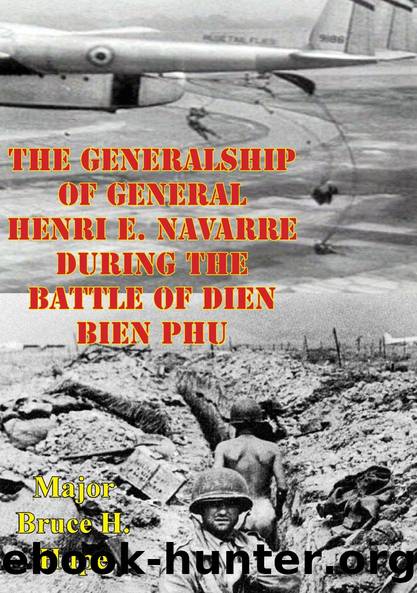The Generalship Of General Henri E. Navarre During The Battle Of Dien Bien Phu by Major Bruce H. Hupe

Author:Major Bruce H. Hupe [Hupe, Major Bruce H.]
Language: eng
Format: epub
ISBN: 9781786250100
Barnesnoble:
Publisher: Normanby Press
Published: 2015-11-06T00:00:00+00:00
Phase II, Reinforcement and Reorganization
The period after the fall of the northern outposts was marked by an overall lull in the battle. Both sides consolidated their positions while General Giap introduced a new tactic to the battle, a re-application of World War I style trench warfare. This time was also marked by a crisis in the French command. as Colonel Castries was, for all practical purposes, relieved by his subordinate officers.
The Viet Minh successfully captured Beatrice, Gabrielle, and Anne-Marie, but at an extremely high price. Exact figures are not available, but most estimates say that the Viet Minh had lost over 2,000 men killed and probably double that number wounded in the battles for Beatrice and Gabrielle; the French lost one-half that number.{145} In order to try and preclude further losses of this magnitude. General Giap ordered his troops to begin digging towards the remaining French positions. As aerial reconnaissance photographs began to indicate an increasingly vast and complex trench system growing around Dien Bien Phu, General Cogny ordered Colonel Castries to begin preparations for counter-trench warfare. Castries replied in a personal telegram that he had neither the personnel, nor the expertise for such operations.{146} Over the next few days, the French began connecting their battle positions with trenches of their own, but the extent of their efforts paled in comparison to those of the Viet Minh.
At this point it became obvious to both General Cogny in Hanoi, and to the battalion commanders at Dien Bien Phu, that Colonel Castries was not prepared for the style of warfare that was to be waged there. Fall, Davidson, and Roy all agree that Cogny agonized for days over the situation, and seriously considered parachuting in and taking personal command of the besieged garrison himself. His staff convinced him otherwise. Instead, the issue was settled at the scene. Lieutenant Colonel Pierre Langlais, a paratroop battalion commander:
âFlanked by the fully armed commanders of the other paratroop battalions at Dien Bien Phu, entered de Castriesâ office and bluntly told him that henceforth the effective command of the fortress would be in his hands, but that as far as the outside world was concerned de Castries would retain the appearance of command and would function as an intermediary between the paratroop commanders and Hanoi.â{147}
Surprisingly, Castries agreed to this arrangement, as did Cognyâs Headquarters in Hanoi, where the benign mutiny was ignored and thus tacitly accepted. General Navarre does not mention it in his accounts. It is probable that Navarre was unaware of what happened. As the commander in chief, he should have been. Even in his memoirs written years after the battle ended, Navarre continued to defend Castries. He wrote that âwhatever the case, I remain convinced that no one which I could have designatedâwhether General and Infantry-would have done better than Colonel de Castries.â{148} Langlais himself later said that, âthough I was only a simple paratroop lieutenant colonel at the beginning of the battle, I had directly under my orders 10,000 men; but nobody in Hanoi or elsewhere sought to deprive me of that handsome command.
Download
This site does not store any files on its server. We only index and link to content provided by other sites. Please contact the content providers to delete copyright contents if any and email us, we'll remove relevant links or contents immediately.
The Radium Girls by Kate Moore(11619)
100 Deadly Skills by Clint Emerson(4688)
The Templars by Dan Jones(4556)
Rise and Kill First by Ronen Bergman(4543)
The Doomsday Machine by Daniel Ellsberg(4244)
The Rape of Nanking by Iris Chang(4022)
Killing England by Bill O'Reilly(3896)
Hitler in Los Angeles by Steven J. Ross(3797)
Stalin by Stephen Kotkin(3724)
12 Strong by Doug Stanton(3418)
Hitler's Monsters by Eric Kurlander(3161)
Blood and Sand by Alex Von Tunzelmann(3055)
Darkest Hour by Anthony McCarten(3017)
The Code Book by Simon Singh(2855)
The Art of War Visualized by Jessica Hagy(2837)
Hitler's Flying Saucers: A Guide to German Flying Discs of the Second World War by Stevens Henry(2623)
Babylon's Ark by Lawrence Anthony(2427)
The Second World Wars by Victor Davis Hanson(2420)
Tobruk by Peter Fitzsimons(2373)
